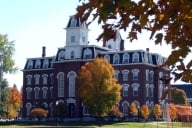You have /5 articles left.
Sign up for a free account or log in.
As projections indicate a growing shortage of new physicians, U.S. medical schools this fall reported their highest-ever enrollments of first-year students -- and increasng percentages of students from underrepresented minorities, the Association of American Medical Colleges said Wednesday.
Total first-year enrollments at the association’s member institutions totaled 18,665, up 1.5 percent from a year ago. The most dramatic gains in matriculants were among students from underrepresented minority groups. In all, 3,141 students who self-identified as African-American or black, Hispanic, American Indian, and Native Hawaiian or Pacific Islander began medical school this fall, up from 2,944 last fall.
“You don’t improve the health of communities without having a work force that reflects the diversity of those communities,” said Darrell G. Kirch, president and CEO of AAMC, referring to the changing ethnic and racial demographics of the United States. According to the association's data, students from underrepresented minority groups represented 16.8 percent of new students at the 133 U.S. medical schools and 17 Canadian schools that award M.D.s. Last year, they accounted for 16.0 percent of the 18,390 new students at those institutions.
About 53 percent of applicants and matriculants were male, while 47 percent were female. Last year, 52 percent were male and 48 percent were female.
The demographic showing the largest percentage growth in number of students entering medical school was Hispanic men. This fall, there were 786 Hispanic male matriculants, up 17.1 percent from 671 a year ago. Association officials couldn’t point to any one reason for the gains. “We’ve been active for decades around improving the diversity of the profession,” Kirch said, as have many individual schools. But, he added, “it’s very hard to make causal links.”
The only group to enroll in smaller numbers this fall was Native Hawaiian and Pacific Islander, down to 61 new students this year, six fewer than a year ago. The number of white students enrolling grew far less dramatically than other groups -- by 0.4 percent -- to 12,094 students.
The racial and ethnic shifts, though, haven’t brought with them a change in the economic backgrounds of new students. Gwen Garrison, AAMC’s director of student and applicant studies, said that about 80 percent of applicants in the last decade have come from the top two quintiles of income. The underrepresentation of low-income students is “something we’ve been monitoring very closely” and a “definite concern” at the association, said Henry Sondheimer, senior director of student affairs and student programs.
First-year enrollments at the 26 U.S. osteopathic medical schools -- which award D.O. degrees -- are also higher this fall than they were in 2009. The American Association of Colleges of Osteopathic Medicine said that more than 5,500 students entered osteopathic programs this fall. Last year, the schools reported 5,162 new students. Wendy Fernando, AACOM’s vice president for communications and marketing, said the group plans to release final statistics for fall 2010 in December.
The AAMC began a push in mid-2006 to encourage the creation of new medical schools and branch campuses, as well as the addition of new seats at existing schools. Its goal was to increase first-year enrollments to more than 21,000 by 2015, up 30 percent from 2002 levels. Kirch said that while AAMC’s 30 percent growth goal won’t be reached by 2015, it should be possible by 2018.
One new school, Virginia Tech Carilion School of Medicine in Roanoke, opened this fall with 42 first-year students. Two other institutions, Oakland University’s William Beaumont School of Medicine, in Michigan, and the Hofstra North Shore-Long Island Jewish School of Medicine, in New York, have received preliminary accreditation from the Liaison Committee on Medical Education and will open their doors to first-year students in 2011. Several other new schools are in the pipeline to open in the next few years.
As of now, the association isn’t advocating for more first-year seats beyond the goal of about 21,000. Rather, its focus is on expanding the capacity of residency programs for medical school graduates, which have not kept pace with the growth in the number of M.D. and D.O. degrees being awarded by U.S. institutions.








